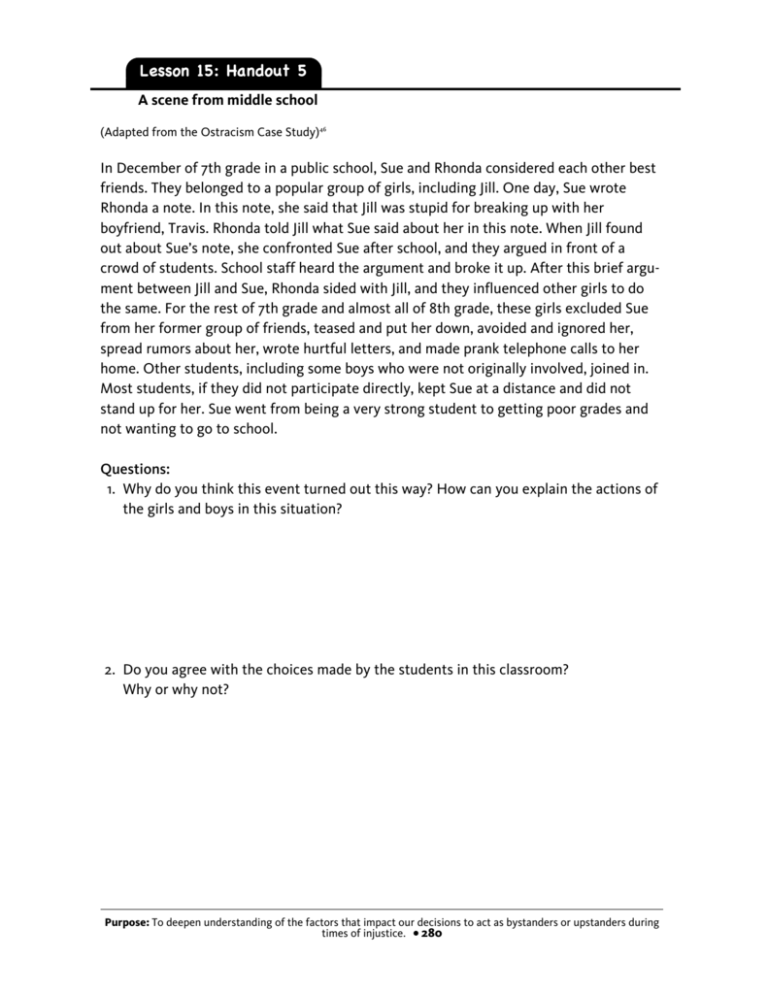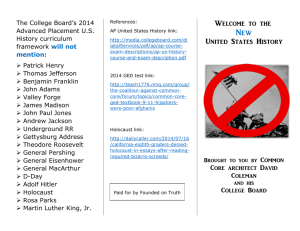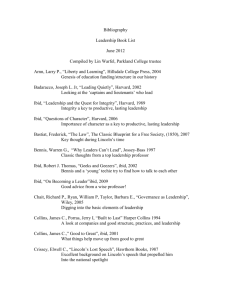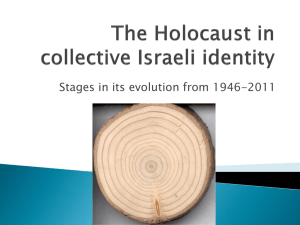Handout 5 - Facing History and Ourselves
advertisement

Lesson 15: Handout 5 A scene from middle school (Adapted from the Ostracism Case Study)46 In December of 7th grade in a public school, Sue and Rhonda considered each other best friends. They belonged to a popular group of girls, including Jill. One day, Sue wrote Rhonda a note. In this note, she said that Jill was stupid for breaking up with her boyfriend, Travis. Rhonda told Jill what Sue said about her in this note. When Jill found out about Sue’s note, she confronted Sue after school, and they argued in front of a crowd of students. School staff heard the argument and broke it up. After this brief argument between Jill and Sue, Rhonda sided with Jill, and they influenced other girls to do the same. For the rest of 7th grade and almost all of 8th grade, these girls excluded Sue from her former group of friends, teased and put her down, avoided and ignored her, spread rumors about her, wrote hurtful letters, and made prank telephone calls to her home. Other students, including some boys who were not originally involved, joined in. Most students, if they did not participate directly, kept Sue at a distance and did not stand up for her. Sue went from being a very strong student to getting poor grades and not wanting to go to school. Questions: 1. Why do you think this event turned out this way? How can you explain the actions of the girls and boys in this situation? 2. Do you agree with the choices made by the students in this classroom? Why or why not? Purpose: To deepen understanding of the factors that impact our decisions to act as bystanders or upstanders during times of injustice. • 280 Notes Raul Hilberg, Perpetrators, Victims, Bystanders: The Jewish Catastrophe 1933–1945 (New York: Harper Collins, 1992), xi. 2 Ervin Straub, The Roots of Evil: The Origins of Genocide and Other Group Violence (Oxford: Cambridge University Press, 1992), 87. 3 Primo Levi, Survival in Auschwitz and the Reawakening: Two Memoirs (New York: Summit Books, 1986), 377. 4 Raul Hilberg, The Destruction of European Jews (New York: Holmes & Meier, 1985), 148–49. 5 Victoria Barnett, For the Soul of the People: Protestant Protest Against Hitler (New York: Oxford University Press, 1992), 164. 6 Gordon J. Horwitz, In the Shadow of Death: Living Outside the Gates of Mauthausen (New York: The Free Press, 1990), 60. 7 Deborah Lipstadt, Beyond Belief: The American Press and the Coming of the Holocaust 1933–1945 (New York: The Free Press, 1986), 172. 8 Ibid., 183. 9 Levi, Survival and Reawakening, 381. 10 Maciej Kozlowski, “The Mission that Failed: A Polish Courier Who Tried to Help the Jews,” as quoted in Antony Polonsky, My Brother’s Keeper? Recent Polish Debates on the Holocaust (Abingdon: Routledge, 1990), 87. 11 David Wyman, The Abandonment of the Jews: America and the Holocaust 1941–1945 (New York: Pantheon Books, 1984), 97. 12 Ibid., 296–97. 13 Ibid. 14 Seeing, VHS (New Haven: Fortunoff, 1982). 15 Daniel Goldman, “Is Altruism Inherited?” Baltimore Jewish Times, April 12, 1985. 16 Guido Calabresi, “Choices,” Williams Alumni Review (Summer 1991). 17 The Courage to Care: Rescuers of Jews During the Holocaust, ed. Carol Rittner and Sondra Myers (New York: New York University Press), x. 18 Ibid., 115. 19 Wyman, The Abandonment of Jews, 287. 20 The Courage to Care, 115. 21 Ibid., 31–33. 22 Calabresi, “Choices.” 23 Ibid. 24 Maurice Ogden, Hangman (Tustin: Regina Publications, 1968). 25 “Martin Niemoeller,” Jewish Virtual Library website, http://www.jewishvirtuallibrary.org/jsource /biography/niemoeller.html (accessed January 22, 2009). 26 The Courage to Care, 102. 27 Carol Rittner, Stephen D. Smith, and Irena Steinfeldt, The Holocaust and the Christian World: Reflections on the Past, Challenges for the Future (London: Continuum International Publishing Group, 2000), 163. 28 “Le Chambon-sur-Lignon,” The Holocaust, Crimes, Heroes and Villains website, http://www.auschwitz.dk/Trocme.htm (accessed January 22, 2009). 29 “Le Chambon-sur-Lignon,” United States Holocaust Memorial Museum website, http://www.ushmm.org/wlc/article.php?lang=en&ModuleId=10007518 (accessed January 22, 2009). 30 Shoah, VHS (New York: Paramount Home Video, 1985). 31 Horwitz, In the Shadow of Death, 61–62. 32 Ibid., 60. 33 Ibid., 61. 34 Nathan Stoltzfus, Resistance of the Heart (Piscataway: Rutgers University Press, 1996), 243. 35 Cristabel Bielenberg, When I Was German 1933–1945: An English Woman in Nazi Germany (Lincoln: University of Nebraska Press, 1998), 112–13. 36 Nechama Tec, When Light Pierced the Darkness (Oxford: Oxford University Press, 1986), 55. 37 Ibid., 176. 38 The Courage to Care, 29–30. 39 Ibid., 94. 40 Carol Rittner, “Denmark and the Holocaust,” Yad Vashem website, http://www1.yadvashem.org/odot_pdf/microsoft%20word%20-%20696.pdf (accessed January 22, 2009). 41 Lipstadt, Beyond Belief, 188. 1 281 Wyman, The Abandonment of Jews, 287. Ibid., 296–97. 44 Helmuth James von Moltke, Letters to Freya: 1939–1945 (New York: Alfred Knopf, 1990), 175. 45 Ibid., 3. 46 Dennis Barr, Jennifer Bender, Melinda Fine, Lynn Hickey Schultz, Terry Tollefson, and Robert Selman. “A Case Study of Facing History and Ourselves in an Eighth Grade Classroom: A Thematic and Developmental Approach to the Study of Inter-Group Relations in a Programmatic Context” (Brookline: Facing History and Ourselves, unpublished manuscript). 42 43 282






